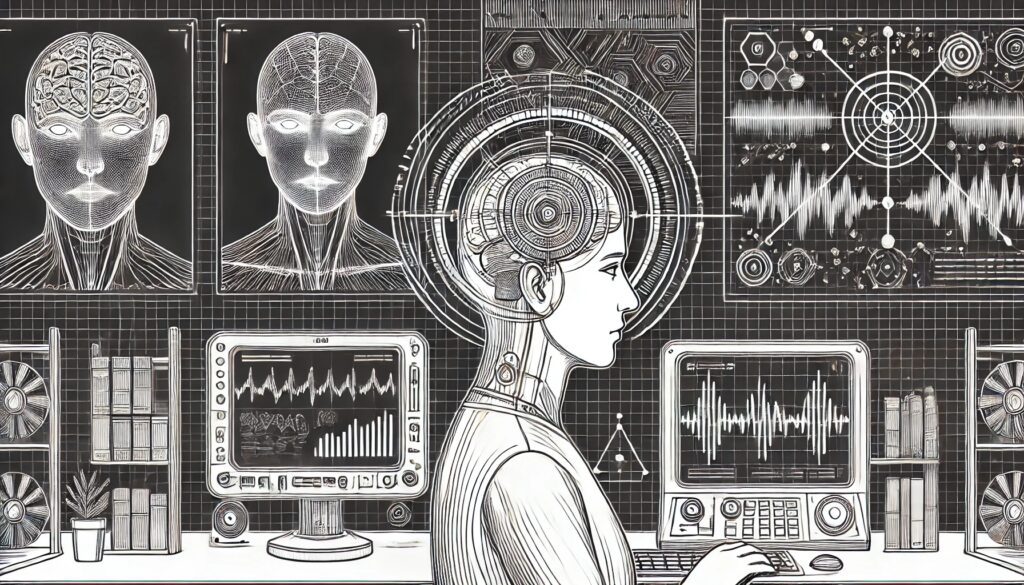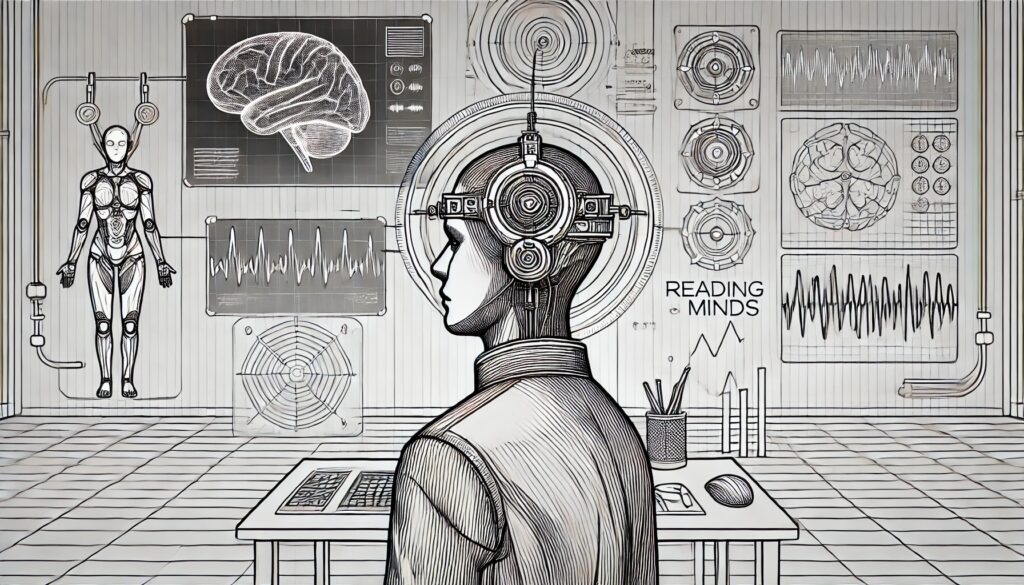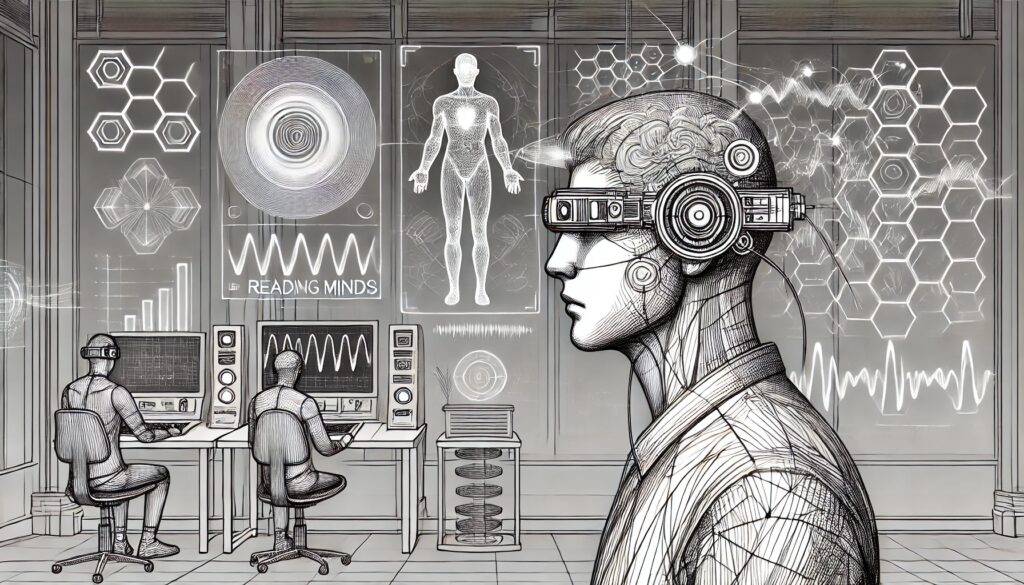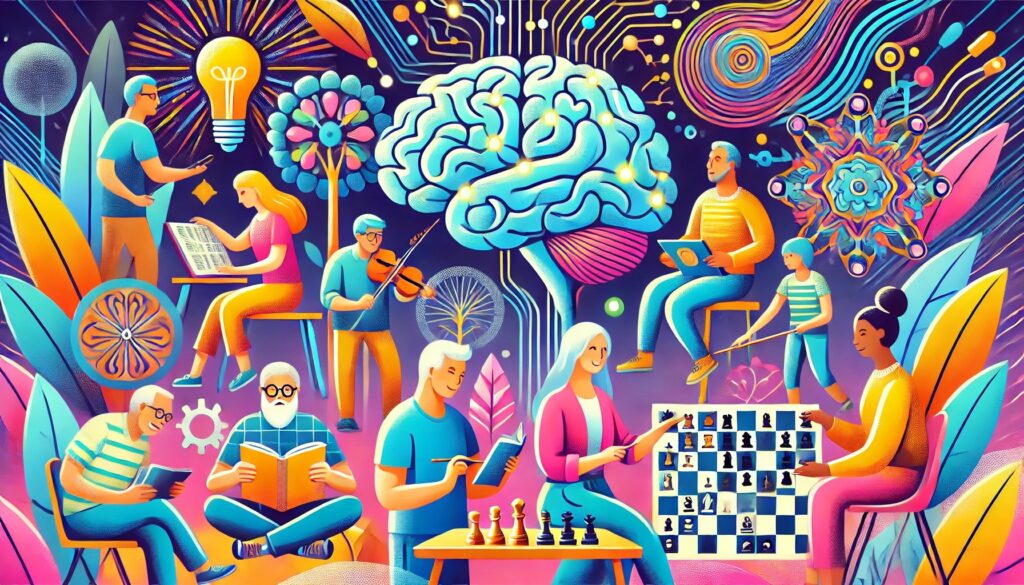
Advances in Reading Thoughts Using EEG Technology
Reading thoughts using an electroencephalogram (EEG) is making progress, according to experts. The development of artificial intelligence (AI) make this possible, at least to a limited extent. For example, it is possible to track whether someone has seen a series or not. This raises some ethical questions, but there are also opportunities.
Introduction to EEG Technology
The Electroencephalogram (EEG) is a groundbreaking tool in neuroscience, offering a non-invasive way to record the brain’s electrical activity. By placing electrodes on the scalp, EEG captures the synchronous activity of large neuron groups, providing insights into brain function and thought processes.
Historical Background
First recorded by Hans Berger in 1924, EEG technology has evolved from rudimentary analog systems to sophisticated digital devices. This evolution has significantly enhanced the precision and capabilities of EEG, allowing for more detailed brain activity analysis.
Technical Aspects
Modern EEG systems employ advanced signal acquisition and processing techniques. These include amplifiers, filters, and complex signal interpretation algorithms. The EEG commonly analyzes frequency bands such as delta, theta, alpha, beta, and gamma, each associated with different brain states and functions.
Current State of EEG in Thought Reading
Recent Advancements
Recent breakthroughs in EEG technology have made significant strides in reading thoughts. The integration of advanced machine learning algorithms has allowed researchers to decode EEG signals with increasing accuracy. These algorithms analyze the complex patterns of brain activity, translating them into interpretable data.
Furthermore, the combination of EEG with other technologies like virtual reality (VR) has enhanced signal interpretation. This integration enables a more immersive and precise understanding of brain activity, opening new avenues for brain-computer interfaces (BCIs) and other applications.
Successful Experiments
Studies have demonstrated the feasibility of using EEG for basic communication. For instance, BCIs have been developed to interpret yes/no answers from patients who are unable to speak. By analyzing the brain’s electrical activity, these systems can accurately decipher simple responses, offering a new mode of communication for those with severe motor impairments.
Research has also focused on decoding simple imagined movements and visualizations. By monitoring the brain’s signals, scientists can identify patterns associated with specific thoughts or actions. These experiments show promise in developing more advanced thought-reading capabilities, potentially enabling more complex interactions with technology.
Comparative Analysis
Comparing EEG with other brain imaging technologies highlights its unique advantages and limitations. Functional Magnetic Resonance Imaging (fMRI) offers higher spatial resolution, allowing for detailed imaging of brain structures. However, EEG provides superior temporal resolution, capturing rapid changes in brain activity with millisecond precision. This makes EEG particularly valuable for real-time applications, such as BCIs.
Magnetoencephalography (MEG) is another powerful tool for brain imaging, offering high spatial and temporal resolution. However, MEG systems are more expensive and less practical for widespread use compared to EEG. The relative affordability and ease of use of EEG make it an attractive option for various applications, despite its lower spatial resolution.
Expert Opinions and Skepticism
Gyula Kovács’ Perspective
Neuroscientist Gyula Kovács emphasizes the current limitations in decoding the content of thoughts using EEG. While EEG technology can capture the brain’s electrical activity, distinguishing complex thought patterns remains challenging. Conventional EEG methods struggle to decode the nuanced and intricate nature of human thoughts, highlighting the need for more sophisticated approaches.
Views from Other Experts
Other leading neuroscientists and cognitive scientists share similar insights. There is a consensus on the necessity for more advanced algorithms and a better understanding of neural coding to accurately interpret thoughts. Experts believe that while significant progress has been made, the field still requires extensive research to overcome the existing hurdles and fully unlock the potential of EEG in thought reading.

Technical Challenges and Limitations
Signal Interpretation
The complexity of brain signals presents a significant challenge in mapping them to specific thoughts. EEG captures the electrical activity of large neuron groups, but translating these signals into coherent thoughts is highly complex. The brain’s electrical signals are intricate and multifaceted, making it difficult to accurately interpret specific cognitive processes.
Another major issue is the problem of noise and artifacts. Muscle movements, eye blinks, and environmental interference can distort EEG readings, complicating the signal interpretation process. These artifacts can mask the subtle brain signals associated with specific thoughts, reducing the accuracy and reliability of EEG-based thought reading.
Individual Variability
Differences in brain anatomy and activity patterns among individuals add another layer of complexity. Each person’s brain is unique, with distinct neural pathways and activity patterns. This variability necessitates personalized models to accurately decode thoughts from EEG data. A one-size-fits-all approach is often ineffective, as individual differences can lead to significant variations in EEG signals.
The need for personalized models is crucial to improving the accuracy of thought decoding. Tailoring algorithms to account for individual brain differences can enhance the precision of EEG interpretations, making the technology more reliable for practical applications.
Spatial Resolution
EEG technology also faces limitations in spatial resolution. Compared to other imaging techniques like fMRI and MEG, EEG struggles to pinpoint the exact neural origins of signals. While EEG provides excellent temporal resolution, capturing rapid changes in brain activity, its spatial resolution is less precise.
This limitation affects the ability to accurately locate the specific brain regions involved in thought processes. fMRI and MEG offer better spatial resolution, allowing for more detailed imaging of brain structures. However, these techniques are often more expensive and less practical for widespread use compared to EEG. Despite these challenges, ongoing research aims to enhance the spatial resolution of EEG through advanced signal processing techniques and hybrid systems that combine EEG with other imaging methods.
Potential Applications and Ethical Considerations
Medical Applications
EEG technology holds immense potential in the medical field, particularly for patients with locked-in syndrome or severe paralysis. By interpreting brain signals, EEG-based communication tools can provide these patients with a means to convey their thoughts and needs, significantly improving their quality of life. Additionally, EEG is invaluable for the early diagnosis and monitoring of neurological disorders such as epilepsy and Parkinson’s disease. Early detection through EEG can lead to timely interventions and better management of these conditions.
Non-Medical Applications
Beyond the medical realm, EEG technology is paving the way for innovative brain-controlled devices and prosthetics. These devices can offer enhanced mobility and functionality to individuals with physical disabilities. Moreover, EEG is revolutionizing human-computer interaction and gaming, enabling users to control applications and games with their thoughts. This advancement not only enhances user experience but also opens up new possibilities for immersive and interactive technologies.
Ethical Concerns
As EEG technology advances, several ethical concerns must be addressed. Privacy issues are paramount, as safeguarding the mental privacy of individuals is critical. Unauthorized access to thought data could lead to significant breaches of personal privacy. Informed consent is another crucial aspect, ensuring that users fully understand the implications of using thought-reading devices. Users must be aware of how their data is collected, used, and protected. Additionally, there is a potential for misuse, such as unauthorized access or manipulation of thought data. Robust security measures and ethical guidelines are essential to prevent such scenarios and protect users’ rights and well-being.
Future Directions and Research
Emerging Techniques
Hybrid systems combining EEG with other neuroimaging methods, such as functional Near-Infrared Spectroscopy (fNIRS) and functional Magnetic Resonance Imaging (fMRI), are among the most promising developments. These hybrid systems aim to leverage the strengths of each technology, providing more comprehensive and accurate brain activity data. Innovations in electrode materials and placement are also crucial for better signal acquisition. Improved materials and strategic electrode positioning can significantly enhance the quality and clarity of the EEG signals, leading to more precise thought decoding.
Ongoing Research
Several key projects are currently underway, funded by prestigious institutions like DARPA, NIH, and the European Union. These projects focus on advancing EEG technology and its applications in thought reading. Collaborative efforts between universities, tech companies, and healthcare organizations are driving innovation and facilitating the development of more effective and reliable EEG systems. These collaborations are essential for pooling resources, expertise, and data to overcome existing challenges and push the boundaries of what’s possible with EEG technology.
Predictions and Goals
In the short term, the primary goal is to improve the accuracy and reliability of thought decoding. Researchers are focused on refining algorithms and techniques to enhance the precision of EEG interpretations. Long-term goals include the development of fully functional brain-computer interfaces (BCIs) capable of enabling complex thought communication and control. These BCIs could revolutionize various fields, from healthcare to technology, by allowing users to interact with devices and systems using only their thoughts.

Case Studies and Practical Examples
Communication for Paralysis
The case of Stephen Hawking is one of the most notable examples of using EEG and other technologies to facilitate communication for individuals with paralysis. Despite his severe physical limitations due to ALS, Hawking utilized advanced communication systems that interpreted minimal physical movements and, in later stages, brain signals to produce speech.
Success stories from clinical trials using brain-computer interfaces (BCIs) for ALS patients highlight the potential of EEG technology. These trials have enabled patients to communicate basic needs and responses through thought-driven systems, significantly improving their quality of life.
Thought-Controlled Devices
Brain-controlled drones and robotic arms are exciting developments in the application of EEG technology. These devices allow users to control movements and actions with their thoughts, showcasing the potential of BCIs in various fields. For instance, individuals can pilot drones or manipulate robotic limbs, offering new possibilities for interaction and control.
Applications in rehabilitation for stroke patients demonstrate the therapeutic potential of EEG-controlled devices. By enabling patients to engage in mental exercises that control virtual or physical limbs, these technologies can aid in the recovery of motor functions and coordination, promoting neuroplasticity and rehabilitation.
Lessons from Failures
Analyzing unsuccessful attempts and technological setbacks provides valuable insights into the challenges of developing reliable EEG-based systems. Failures often stem from issues such as signal noise, inconsistent data interpretation, and user variability. These setbacks underscore the importance of addressing technical and methodological limitations.
Insights into the importance of robust experimental design and user training have emerged from these failures. Ensuring that experimental setups are well-structured and that users are adequately trained to interact with EEG systems can mitigate some of the common issues and enhance the reliability of thought-controlled technologies. This approach is crucial for advancing the field and achieving more consistent and effective outcomes.
Public Perception and Societal Impact
Public Awareness
Surveys and studies have been conducted to gauge public understanding and acceptance of EEG technology. These surveys reveal varying levels of awareness, with some segments of the population being more familiar with the potential applications and benefits of EEG, while others remain skeptical or uninformed. The role of the media is crucial in shaping public perceptions and addressing misconceptions. Positive media coverage can enhance understanding and acceptance, while negative or sensationalist reporting can lead to fear and misunderstanding.
Societal Benefits
EEG technology has the potential to significantly improve the quality of life for individuals with disabilities. By enabling communication and control through brain signals, EEG-based systems can provide new avenues for interaction and autonomy. Additionally, advancements in education and training through neurofeedback techniques offer promising benefits. Neurofeedback can help individuals improve cognitive functions, manage stress, and enhance learning capabilities, thereby contributing to overall well-being and educational outcomes.
Negative Impacts
Despite its benefits, the pervasive use of brain-computer interfaces (BCIs) and EEG technology poses certain risks. One major concern is the possible exacerbation of socio-economic inequalities. Access to advanced EEG technologies may be limited to those with financial means, widening the gap between different socio-economic groups. Furthermore, there are risks of dependency and reduced agency. As individuals become more reliant on BCIs for daily functions, there may be a decline in traditional skills and an increased dependency on technology, potentially reducing personal autonomy and decision-making capabilities.
Summary
The exploration of EEG technology for thought reading has shown both significant potential and notable limitations. Current capabilities allow for the interpretation of basic brain signals and the facilitation of communication for individuals with severe disabilities. However, challenges such as signal noise, individual variability, and limited spatial resolution highlight the need for ongoing advancements. Interdisciplinary efforts involving neuroscientists, engineers, ethicists, and policymakers are crucial to overcoming these obstacles and advancing the field.
Optimism vs. Skepticism
Balancing optimism with realistic expectations is essential. While the promise of EEG technology in reading thoughts is compelling, it’s important to acknowledge the technical and ethical challenges that remain. The potential for misuse and the need for robust data interpretation methods necessitate a cautious yet hopeful approach. By tempering excitement with careful consideration of the limitations, the field can progress responsibly.
Future Outlook
Continued research and ethical considerations are paramount as we move forward. Encouraging responsible development and integration of EEG technology into society will ensure that its benefits are maximized while minimizing potential risks. The vision for the future includes a world where EEG technology is seamlessly and ethically integrated, improving lives and expanding the possibilities of human-computer interaction.
Additional Considerations
Interdisciplinary Collaboration
Collaboration between diverse fields is essential. Neuroscientists, engineers, ethicists, and policymakers must work together to address the multifaceted challenges of EEG technology. This collaboration will drive innovation and ensure that the technology is developed and deployed responsibly.
Funding and Resources
Governmental and private funding play a critical role in advancing EEG research. Sustained financial support from both sectors is necessary to foster innovation, conduct large-scale studies, and develop practical applications. Funding initiatives can accelerate progress and help overcome existing technological and ethical hurdles.
Educational Initiatives
Educational programs are crucial for training future researchers and informing the public about the potential and limitations of EEG technology. By fostering a well-informed community of scientists and citizens, we can ensure responsible development and application of this powerful technology. Educational initiatives should focus on the scientific, ethical, and practical aspects of EEG, preparing the next generation to continue advancing the field responsibly.





